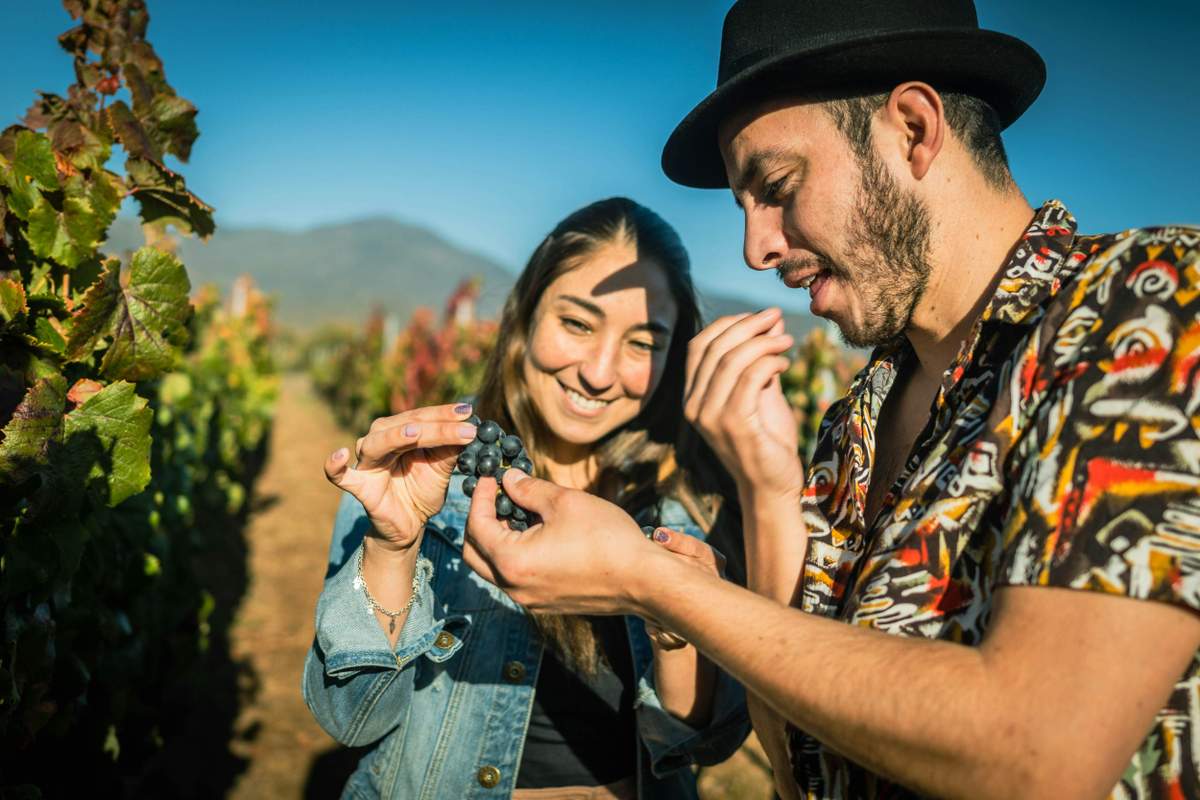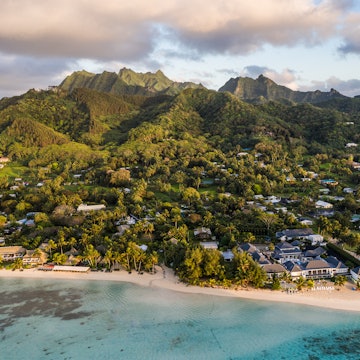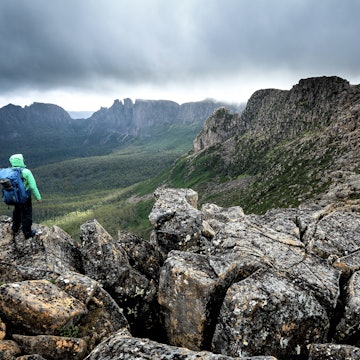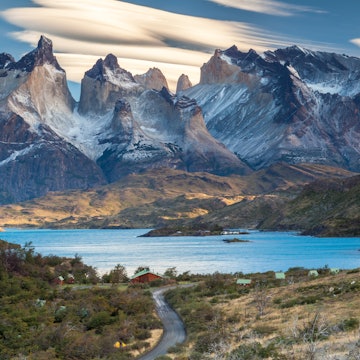

Centro Gabriela Mistral in Santiago, Chile. Diego Grandi/Shutterstock
Nearly every trip to Chile begins in Santiago, an often underestimated city that brims with culture, character and boundless sunshine. Few global capitals boast such a dramatic setting: glittery skyscrapers rise against the backdrop of the Andes to the east. In between the peaks sprawls a city of some 7 million people – a third of all Chileans. No other city in the country comes even close in size or influence, so if you want to check the pulse of the nation, spend time in its beating heart.
Santiago defies easy categorization. Perhaps the city is best thought of as a collection of distinct neighborhoods, each with its own flavor. Centro is the city’s historic core, home to stately government buildings and the best museums and cultural centers. The bohemian neighborhoods of Lastarria, Bellavista and Barrio Italia are known, respectively, for dining, nightlife and shopping; grittier Barrio Yungay and Barrio Brasil entice with vibrant street art. Affluent eastern neighborhoods, including Las Condes and Vitacura, are modern, shiny and high-rise, offering a vision of Chile’s future.
Stick around for a few days and you’ll discover a fascinating city full of syncopated cultural currents, madhouse parties, frenetic markets, expansive museums, hilly parks, rich immigrant communities and top-flight restaurants. Here’s everything a first-time visitor to Santiago needs to know.

When should I go to Santiago?
Santiago is appealing and sunny in all four seasons – even if the bulk of visitors arrive in the austral summer (December to March) before setting out to hike in Chile’s fabulous national parks or lounge on the beach. Summer highs can reach 30°C (86°F), though the city’s high altitude means that evenings stay cool, dipping to 11°C (52°F). Winters (June to September) can be cold but not bitter, with below-freezing temperatures unusual and an average high of a lovely 15.5°C (60°F). Winter, of course, is also when the nearby ski resorts in the Andes are in full swing.
Spring (September to November) is a beautiful time to visit Santiago: the weather is balmy and the purple-blossomed jacaranda trees are in bloom. Fall (March to May), meanwhile, is when the grapes are harvested at the vineyards and pisco (grape brandy) distilleries that lie in the valley beyond.
Culture lovers might consider a visit in January, when the Teatro a Mil performing-arts festival dominates the cultural scene in Santiago, with street and theater performances by international artists.
How much time should I spend in Santiago?
Travelers have historically viewed the Chilean capital as a necessary pit stop before onward journeys to Patagonia, Rapa Nui or the Atacama Desert. But the city truly merits more than a single overnight.
A 3-day visit is ideal for a thorough intro to the metropolis. During the daytime, you can balance history (at the sites of Santiago Centro and the moving Museo de la Memoria y los Derechos Humanos) with culture (at Pablo Neruda’s enchanting home, La Chascona, or via the murals of Barrio Yungay) and still find time to linger in the city’s many green spaces, including the famous hilltop Parque Metropolitano. Three days also allow for sampling plenty of the city’s excellent bars, restaurants and markets.
Tacking on a few more days will let you explore some of the attractions within easy distance of the city. Escape to the nearby Cajón del Maipo to prepare for Patagonian hikes or just enjoy the fresh mountain air as condors soar overhead. Within an hour of the city are wineries offering tastings, tours, picnics, bike rides and multicourse lunches. In the winter months, head east to Andean resorts like Portillo or Valle Nevado for some of the best skiing in the southern hemisphere.

Is it easy to get in and around Santiago?
Yes, very. Since traffic can be dicey in the huge city, do as the locals do and stick to public transport. Indeed, the Santiago Metro is one of the best public transportation systems in the Americas and the easiest way to get around town. Purchase a Tarjeta bip! at any station, then top it up to use both the metro and public buses.
Taxis are readily available throughout the city, though many travelers prefer the ease and safety of using rideshare apps like Uber and Cabify. Short journeys are typically quite affordable.
Though surrounded by mountains, Santiago itself is actually pretty flat and excellent for biking, with a growing network of ciclovías (bike lanes). For east–west travel, the ciclovía alongside Río Mapocho is particularly handy. A few competing bikeshare companies operate here; Bike Itaú is the most common.
The cheapest way to get downtown from the airport is via bus 555 or private buses Turbus and Centropuerto, which take you to Pajaritos, where you can transfer to the metro. For a shared or private taxi, stop by the counters just after customs. Rideshare apps are technically illegal at the airport, though many travelers use them clandestinely.
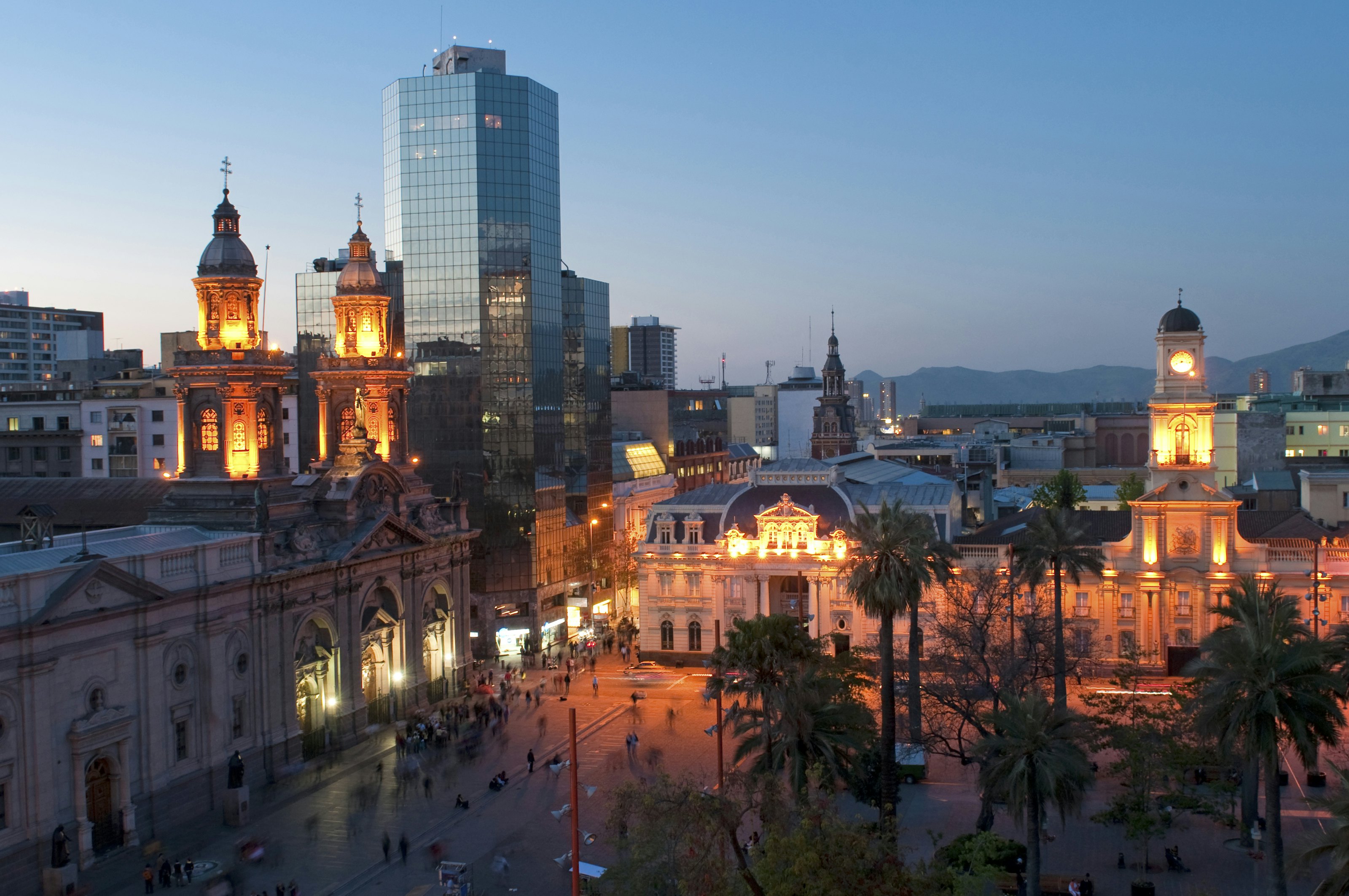
Top things to do in Santiago
Start with a walking tour of Centro
Even if you only have one day in Santiago, you’ll want to set out on a 2.5km scenic walk that takes you to top sites and museums in the city’s historic core.
Begin at Plaza de Armas, which has been the city’s symbolic heart since its founding in 1541; these days, it holds a fountain celebrating libertador (liberator) Simón Bolívar and dozens of Chilean wine palms. Towering above the northwestern corner is the neoclassical Catedral Metropolitana, built between 1748 and 1800. At the northern edge of the plaza is the stately Museo Histórico Nacional, while the porticos on the eastern edge hold a string of nice restaurants.
Take Compañia de Jesús west from the plaza past the Museo Chileno de Arte Precolombino to the Palacio de los Tribunales de Justicia, a neoclassical building housing Chile’s Supreme Court. Head west then south to Palacio Pereira, a renovated mansion with an atmospheric coffee shop and edgy art exhibitions.
Continue one block more and go east to Plaza de la Constitución, a flag-filled park in front of the presidential palace, Palacio de La Moneda (originally the national mint), whose north facade was badly damaged by missile attacks during the 1973 coup that ousted President Salvador Allende. A monument honoring the fallen leader now stands in the plaza.
Stop in beneath La Moneda to view art at Centro Cultural La Moneda before finishing up with a meal nearby at Salvador Cocina y Café, a classically inspired Chilean lunch spot with an upmarket touch.

Enter the whimsical world of Pablo Neruda’s La Chascona
When poet Pablo Neruda needed a secret hideaway to spend time with his mistress Matilde Urrutia, he built La Chascona. Loosely translated as “Messy Hair,” the villa’s name was inspired by Urrutia’s famously unruly curls. Since Neruda was such a lover of the sea, the dining room is modeled on a ship’s cabin and the living room on a lighthouse.
Audio tours (available in several languages) take you through the history of the building and the collection of colored glass, shells, furniture and artwork by famous friends. Sadly, much more was lost when the house was ransacked during the dictatorship. This is also the headquarters of Fundación Neruda, which maintains Neruda’s three houses (the others are in Valparaíso and on Isla Negra).

See the views from Cerro San Cristóbal
You’ll find the best views of Santiago from the peaks and viewpoints of Parque Metropolitano, better known locally as Cerro San Cristóbal. At 736 hectares, the park is Santiago’s largest green space, but it’s still decidedly urban: a funicular on one side carries you from Bellavista to the top, while a teleférico (cable car) on the other swoops you away toward the neighborhood of Providencia.
A snowy white 14m-high statue of the Virgen de la Inmaculada Concepción towers atop the cumbre (summit) at the Bellavista end and is visible from everywhere downtown. Just below is Terraza Bellavista, with a few snack stands and extraordinary city views. (Views of the Andes are best following winter rains, when the sky is clear and the mountains are accentuated by snow.) A drink made from dried peaches and husked wheat berries, mote con huesillo, is the classic park treat.

Confront Chile’s difficult history at a moving museum
The free Museo de la Memoria y los Derechos Humanos is a powerful institution of self-reflection. This striking “Museum of Memory” explores the terrifying human rights violations and large-scale “disappearances” that took place under Chile’s military rule, when some 40,000 victims were subjected to torture and execution. It’s an unmissable stop to learn not only about this dark period in Chilean history but also how its repercussions vibrate across society to this day.
At one of the few Chilean museums with English translations, exhibits take you on a journey from the 1973 coup up to the return to democracy in 1990 and the search for justice thereafter. Protest art and artifacts, victim testimonials and photos of the disappeared make it a visceral and unmissable experience.

Shop Chile’s bounty at the city’s famed food markets
La Vega Central is Santiago’s sprawling vegetable market. In recent years, it has become so unwieldy that the government built a more tourist-friendly version, Tirso de Molina, just in front. Decide your comfort level, pick your market, and look out for local fruits such as tuna (prickly pear) and cherimoya (which has a blend of pineapple, banana and strawberry flavors), as well as vegetables like papas chilotas (colorful potatoes endemic to Chilé).
Across Río Mapocho, the beautiful wrought iron Mercado Central, with its gleaming piles of fresh fish and crustaceans atop mounds of sparkling ice, thrills foodies and photographers. Look for staples from the Pacific coast, including congrio (conger eel), locos (Chilean abalone), piure (an orange tunicate) and erizos (sea urchins).

Get charmed by arty Lastarria
More than any other part of the city, Barrio Lastarria wins the hearts of Santiago visitors. Sandwiched between Parque Forestal, Cerro Santa Lucía and Plaza Italia, Lastarria brims with appealing places to visit. The star attraction is Centro Gabriela Mistral, a striking cultural and performing arts venue with concerts, experimental theater, contemporary dance and other shows most days of the week.
Nearby, José Victorino Lastarria is Santiago’s most charming street, lined with cafes and restaurants and packed with buskers. Cine Arte El Biógrafo is Santiago’s preeminent art-house cinema, while the sleek little Museo de Artes Visuales has four open-plan galleries of contemporary art.
At the far end of the barrio lies the Museo Nacional de Bellas Artes and the attached Museo de Arte Contemporáneo, both housed in a stately neoclassical palace. The former is a fine arts museum with a decent permanent collection of Chilean art and more exciting temporary exhibitions. The latter stages temporary shows of photography, design, sculpture, installation, digital art and other modern works.

See the street murals in historic Barrio Yungay
Just west of Centro, Barrio Yungay has a pride of heritage in protecting both buildings and culture that you won’t find anywhere else in Santiago. That’s because residents mobilized in 2006 to form the city’s first community-led heritage organization, which has opposed the construction of high-rise buildings ever since. The result is a low-rise district with a strong sense of identity and commitment to honoring the past. The checker-tiled Pasaje Adriana Cousiño and cobblestone Pasaje Lucrecia Valdés are among the most scenic spots to get a sense of the area’s glory days.
One of the best reasons to visit this part of town is to wander Yungay’s sleepy streets, many of which follow abandoned trolley lines, as you gaze at the astounding murals covering the historic homes. The streets between Parque Portales and Santo Domingo are generally your best bet for lavish murals from such artists as Sofrenia, STFI, PabloEtrom and Pikoenelojo Stencil.

Taste fine wines in the Maipo Valley
When you’ve had your fill of Santiago’s museums and plazas, head south of the city center to check out the gorgeous family vineyards and mass-production wine operators of the Maipo Valley. Big-bodied reds are what this area is all about: varietals such as merlot, Carmenere and syrah are all present, but cabernet sauvignon is the real star.
More than 30 vineyards are open to visitors in the greater Maipo Valley. If you like wine, you’ve probably already tried Concha y Toro, one of the world’s 10 biggest wine brands. Visit the lavish grounds or sample by the glass at the wine bar. Maipo’s other powerhouse, Santa Rita, has enough restaurants, tours and activities to keep you around for hours.
Historic Cousiño Macul is one of the only vineyards still carving a green patch within Santiago’s urban sprawl (though most of its vines are 40km away in Buin), thanks to its charming winery building from 1872. Sparkling wine specialist Undurraga dates to 1885 and is the most popular (and attractive) vineyard in the lesser-visited Talagante area.
Higher-minded Haras de Pirque is perched on a hilltop and offers tours through its horseshoe-shaped winery. The sunset experience concludes with a meal in a citadel-like restaurant.

Take a hike in the Andes to see soaring condors
Set in the Andes high above the capital, Parque Nacional Glaciares de Santiago was created in 2022 to protect the glaciers that are vital to the city’s water supply and a key habitat for native fauna, such as black-chested buzzard eagles, colocolo wildcats and pumas. Even though the park protects lands only above 3600m – far from any existing roads – visitors can still explore the preserve by driving into the Cajón del Maipo then setting out on foot. Here, you’ll find greater Santiago’s most spectacular half-day hike, Mirador de Cóndores, a 9km out-and-back trail that takes you up to a clifftop where condors soar at eye level.
How much money do I need for Santiago?
Funicular to the top of Cerro San Cristóbal: 2500 Chilean pesos (CH$).
Lunch at Mercado Central: from CH$12,000
Admission to Museo Nacional de Bellas Artes and Museo de Arte Contemporáneo: both free
Wine tour and tasting at Concha y Toro: from CH$26,000
This article was adapted from Lonely Planet’s Chile & Rapa Nui guide, published in October 2025.






